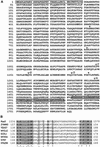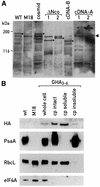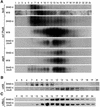Identification of an RNA-protein complex involved in chloroplast group II intron trans-splicing in Chlamydomonas reinhardtii
- PMID: 11285239
- PMCID: PMC145512
- DOI: 10.1093/emboj/20.7.1765
Identification of an RNA-protein complex involved in chloroplast group II intron trans-splicing in Chlamydomonas reinhardtii
Abstract
In Chlamydomonas reinhardtii, the psaA mRNA is assembled by a process involving trans-splicing of separate transcripts, encoded at three separate loci of the chloroplast genome. At least 14 nuclear loci and one chloroplast gene, tscA, are needed for this process. We have cloned Raa3, the first nuclear gene implicated in the splicing of intron 1. The predicted sequence of Raa3 consists of 1783 amino acids and shares a small region of homology with pyridoxamine 5'-phosphate oxidases. Raa3 is present in the soluble fraction of the chloroplast and is part of a large 1700 kDa complex, which also contains tscA RNA and the first psaA exon transcript. These partners, in association with other factors, form a chloroplast RNP particle that is required for the splicing of the first intron of psaA and which may be the counterpart of eukaryotic snRNPs involved in nuclear splicing.
Figures





Similar articles
-
A novel multifunctional factor involved in trans-splicing of chloroplast introns in Chlamydomonas.Nucleic Acids Res. 2006 Jan 10;34(1):262-74. doi: 10.1093/nar/gkj429. Print 2006. Nucleic Acids Res. 2006. PMID: 16407333 Free PMC article.
-
A factor related to pseudouridine synthases is required for chloroplast group II intron trans-splicing in Chlamydomonas reinhardtii.EMBO J. 1999 Nov 15;18(22):6481-90. doi: 10.1093/emboj/18.22.6481. EMBO J. 1999. PMID: 10562560 Free PMC article.
-
Characterization of Mbb1, a nucleus-encoded tetratricopeptide-like repeat protein required for expression of the chloroplast psbB/psbT/psbH gene cluster in Chlamydomonas reinhardtii.Proc Natl Acad Sci U S A. 2000 Dec 19;97(26):14813-8. doi: 10.1073/pnas.97.26.14813. Proc Natl Acad Sci U S A. 2000. PMID: 11121080 Free PMC article.
-
RNA trans-splicing: identification of components of a putative chloroplast spliceosome.Eur J Cell Biol. 2010 Dec;89(12):932-9. doi: 10.1016/j.ejcb.2010.06.015. Epub 2010 Aug 11. Eur J Cell Biol. 2010. PMID: 20705358 Review.
-
The Chloroplast Trans-Splicing RNA-Protein Supercomplex from the Green Alga Chlamydomonas reinhardtii.Cells. 2021 Feb 1;10(2):290. doi: 10.3390/cells10020290. Cells. 2021. PMID: 33535503 Free PMC article. Review.
Cited by
-
Function of chloroplast RNA-binding proteins.Cell Mol Life Sci. 2011 Mar;68(5):735-48. doi: 10.1007/s00018-010-0523-3. Epub 2010 Sep 17. Cell Mol Life Sci. 2011. PMID: 20848156 Free PMC article. Review.
-
Genetic and biochemical analysis of the TLA1 gene in Chlamydomonas reinhardtii.Planta. 2010 Feb;231(3):729-40. doi: 10.1007/s00425-009-1083-3. Epub 2009 Dec 15. Planta. 2010. PMID: 20012986 Free PMC article.
-
PPR14 Interacts With PPR-SMR1 and CRM Protein Zm-mCSF1 to Facilitate Mitochondrial Intron Splicing in Maize.Front Plant Sci. 2020 Jun 12;11:814. doi: 10.3389/fpls.2020.00814. eCollection 2020. Front Plant Sci. 2020. PMID: 32595685 Free PMC article.
-
A pentatricopeptide repeat protein facilitates the trans-splicing of the maize chloroplast rps12 pre-mRNA.Plant Cell. 2006 Oct;18(10):2650-63. doi: 10.1105/tpc.106.046110. Epub 2006 Oct 13. Plant Cell. 2006. PMID: 17041147 Free PMC article.
-
The translational apparatus of Chlamydomonas reinhardtii chloroplast.Photosynth Res. 2004;82(3):315-25. doi: 10.1007/s11120-004-2440-5. Photosynth Res. 2004. PMID: 16143843
References
-
- Ausubel F.A., Brent,R., Kingston,R.E., Moore,D.D., Seidman,J.G., Smith,J.A. and Struhl,K. (1998) Current Protocols in Molecular Biology. John Wiley & Sons, New York, NY.
-
- Bennoun P. and Delepelaire,P. (1982) Isolation of photosynthesis mutants in Chlamydomonas. In Edelman,M., Hallick,R.B. and Chua,N.H. (eds), Methods of Chloroplast Molecular Biology. Elsevier Biomedical Press, Amsterdam, The Netherlands, pp. 25–38.
-
- Cech R.T. (1986) The generality of self-splicing RNA: relationship to nuclear mRNA splicing. Cell, 44, 207–210. - PubMed
-
- Choquet Y., Goldschmidt-Clermont,M., Girard-Bascou,J., Kuck,U., Bennoun,P. and Rochaix,J.D. (1988) Mutant phenotypes support a trans-splicing mechanism for the expression of the tripartite psaA gene in the C.reinhardtii chloroplast. Cell, 52, 903–913. - PubMed
Publication types
MeSH terms
Substances
Associated data
- Actions
- Actions
LinkOut - more resources
Full Text Sources
Other Literature Sources

